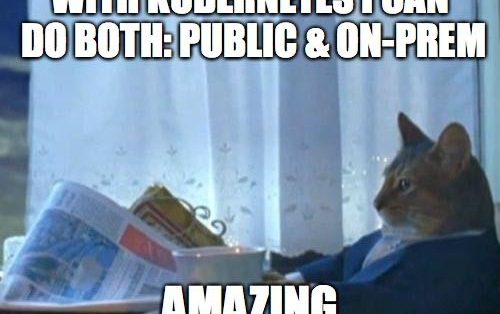This is part 5 in Julio Gomez’s series of blogs on DevOps. Find previous blogs in Julio’s DevOps series here.
Using public Cloud providers services (like GCP, AWS or Azure) is a nice option for multiple scenarios. Let’s say you do not have any on-premises infrastructure and would like to quickly deploy a new application. Or you do not want to deal with maintaining that infrastructure, so you would rather pay for the service and have someone else do it for you. Or you are not sure about how successful your application will be, and you could use the elasticity provided by Cloud services. In any of those cases Cloud deployments might be a good fit for you, and Cloud providers offer many different services around IaaS, PaaS and SaaS.
For our learning lab today we would like to keep on using a scheduler (like Kubernetes, aka k8s), to help us deploy an example modern microservices-based application, in the same way we have done in previous posts.
 Epiphany 1: this cat just realized k8s is great
Epiphany 1: this cat just realized k8s is great
One option would be to get some virtual machines from any Cloud provider and build our own Kubernetes cluster from scratch. But we already explored how to build a cluster in the ‘Operations on-premises’ post, earlier in this blog series.
Let’s try an easier way. Some of these Cloud providers offer the option of providing you with a managed Kubernetes service. This means they can give you pre-installed nodes, so that you can focus only on operating the solution. So… why not? We will choose a managed Kubernetes service for our learning lab today.
- Google Cloud Platform offers Google Kubernetes Engine (GKE)
- Amazon Web Services has their Amazon Elastic Container Service for Kubernetes (EKS) currently only in preview
- Microsoft Azure has Azure Container Service (AKS)
Any of them could work for you, but for my new ‘Operations in Public Cloud’ Learning Lab I have chosen GKE. If you have an account with Google, and register for GCP, you will automatically have $300 to spend on GCP resources over 1 year, including of course GKE. So, it is really convenient, and more than enough to get you started with this type of managed Kubernetes services.
I will guide you on how to set your environment, connectivity and how to deploy our example modern microservices-based application example into a public Cloud environment.
Go for it and have fun… see you in my next post, stay tuned!
Any questions or comments please let me know in the comments section below, Twitter or LinkedIn.
We’d love to hear what you think. Ask a question or leave a comment below.
And stay connected with Cisco DevNet on social!
Twitter @CiscoDevNet | Facebook | LinkedIn
Visit the new Developer Video Channel

Very nice list! Help me a lot. Thank you for sharing!! Let’s say you do not have any on-premises infrastructure and would like to quickly deploy a new application.
http://binaryinformatics.com/dev_ops.html